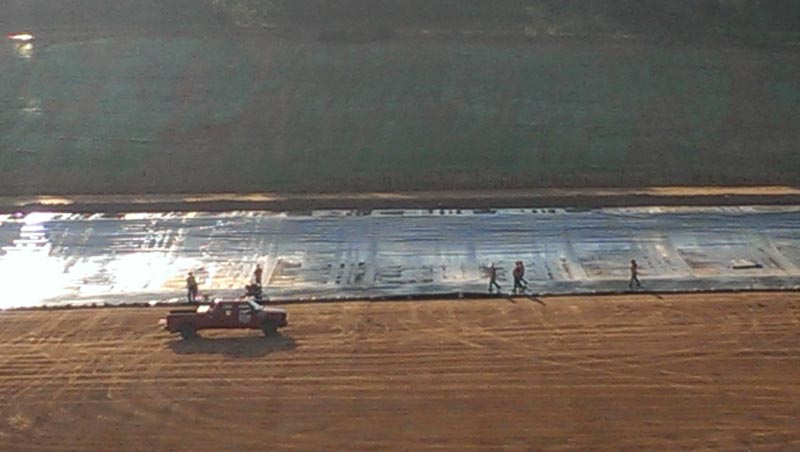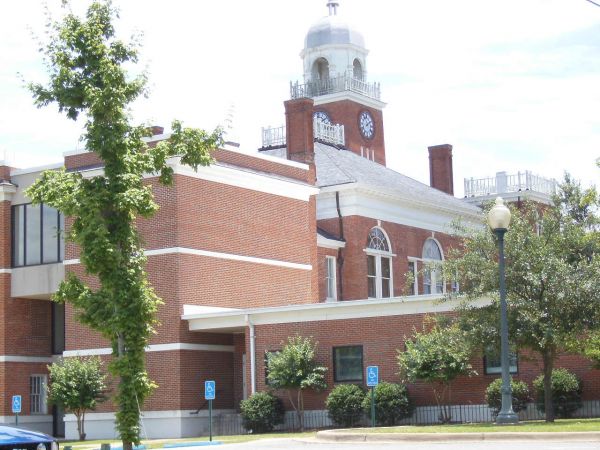

This is the first of two articles about the operation of the Decatur County Solid Waste Facility off U.S. 27 South, near the Florida-Georgia border.
Several “new” Decatur County commissioners toured the county’s massive landfill off U.S. Highway 27 South on Tuesday morning, and had the opportunity to watch workers putting down a plastic liner along the bottom of a large area where solid waste will be stored in the near future.
Attending were county commissioners elected in May, Pete Stephens and George Anderson, as well as two men who are candidates for a county commission seat that will be decided in the November election, Rusty Davis and Joe Putnal. Other county officials taking part in the tour were County Administrator Gary Breedlove, Director of Enviromental Services Suzanne Brandt.
Landfill staff included manager Andrew Jones, assistant manager James Doyle, scale operator Bill Snead and cell construction contractor Billy Leverette. There are currently six inmates from the Decatur County Correctional Institute who operate heavy equipment used in both cell construction and garbage compaction. They are supervised by DCCI guards.
The landfill off U.S. 27 South, which opened in 2006, has almost filled up three of seven “cells,” or plots of land, that are included in the landfill design that federal environmental officials have approved to date. Cell 3 is about 12 months away from being full, and rises in a tall hill above the rest of the landfill. Cell 4, adjacent to Cell 3, is about 800 feet long by 350 feet wide, according to landfill construction manager Billy Leverette, and will provide another three years’ worth of solid waste capacity, at current disposal rates.
In all, the current landfill has about six million yards of air space where garbage can be stacked up to fill, the county’s landfill engineer Steve Harbin said.
Harbin helped lead the tour for county commissioners. He explained how landfills, while often referred to as “dumps,” are actually very sophisticated in their design and construction, in part to make them environmentally safe and partly to maximize the amount of solid waste that can be stored. In addition to engineers who design the landfill, there’s also construction engineers who are on site right now to make sure the landfill is built correctly.

First, more than 300,000 yards of dirt had to be moved to build up the site where Cell 4 will go, because it was at a significantly lower elevation than the small mountain that Cell 3 has become, Leverette said. The base of Cell 4 looks like a football field crossed with a bathtub; trenches are dug out to form the barriers and there are sloping sides to contain the area, although it will eventually “bleed over” into a fifth cell that will go where an old pond is at the moment.
“Building the landfill is like a 30-year construction project,” Harbin said. “Laying out the seven cells next to each other is kind of like putting together a 3D jigsaw puzzle. When the landfill is finished and full, it will look like a long green-covered ridge.”

Workers began laying down a polyethylene liner (polyethylene – plastic polymer of ethylene used chiefly for containers, electrical insulation, and packaging) that is about as thick as a stack of 60 sheets of paper, Harbin said. On top of the plastic, two feet of sandy soil and rocks are laid down as a way of filtering out the liquids from the solids.
Part of what makes the overall landfill project so complex is because each cell has a system of leachate pipes: any liquid that comes in with the garbage eventually trickles down to the low points in the cell, where the liner will have small perforations to allow liquid to flow into a long plastic pipe. Because of environmental concerns, you don’t want the liquid brought into the landfill to somehow find its way into the ground or nearby water sources, Harbin said.

Those leachate pipes basically form a sewer system that runs back to a tall metal holding tank near the front entrance of the landfill. The leachate is treated and eventually recirculated back onto the various cells, which actually helps clean out the garbage sites. Visiting the landfill is really not that smelly; the only places it smells are where garbage has just been deposited that same day. Each evening the newest sections of the landfill are covered with plastic, according to environmental regulations, a practice which helps keeps rats and birds out of the garbage.

Below is a video of the liner being laid out over what will become Cell 4. The workers have to be careful not to allow the liner to lay too loosely or too tightly. If it’s too loose, air pockets can develop underneath. If it’s too tight, the liner can become too taut due to cold weather or compression of having tons of garbage stacked on top. The overall goal is to prevent any situation that could lead to the landfill liner ripping, and leaking liquid into the ground.
It’s a multi-step, fairly fast moving process. The big machine lays down the polyethylene liner along a stretch of ground, and then workers clamp on to the edge of the liner and pull it tight. The liner is laid down in mostly parallel rows; sometimes the orientation of the rows is switched up depending on the elevation around the edges of the cell.
The video preview is small for viewing on mobile phones; click on the video to make it larger.
A self-guided machine that looks like a robot vacuum comes along and heats up the edges of the plastic where the rows meet, essentially melting it to create a sealed seam. A worker watches the machine’s progress and walks alongside it with a brush that he uses to sweep away any dirt that might be along the seam line; if grit gets in the seam, it can increase the chance of the plastic ripping.
In the next article on the Decatur County Solid Waste Facility, we will tell you about the different kinds of equipment that is used at the landfill, how much garbage is brought into the landfill every month, how the landfill is operated as a revenue-earning business, and future plans for the landfill’s expansion.











Brennan, well done article! You described the site and the operation accurately and concisely.
Thanks, Brennan! You may be ready to take the test soon:)
Job well done my man. Thanks for taking time to visit the site with us and sharing your thoughts in a public forum. Great job.